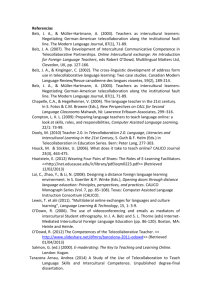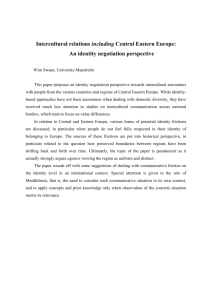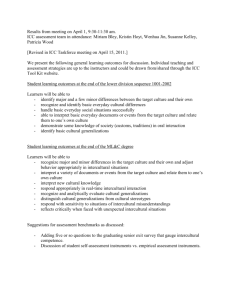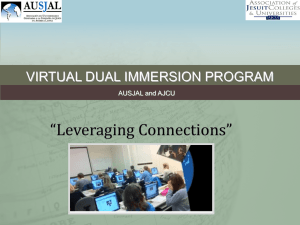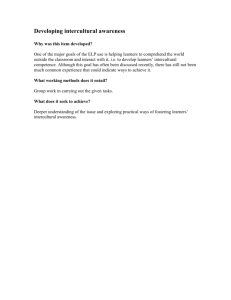- SEAMEO Regional Training Centre
advertisement
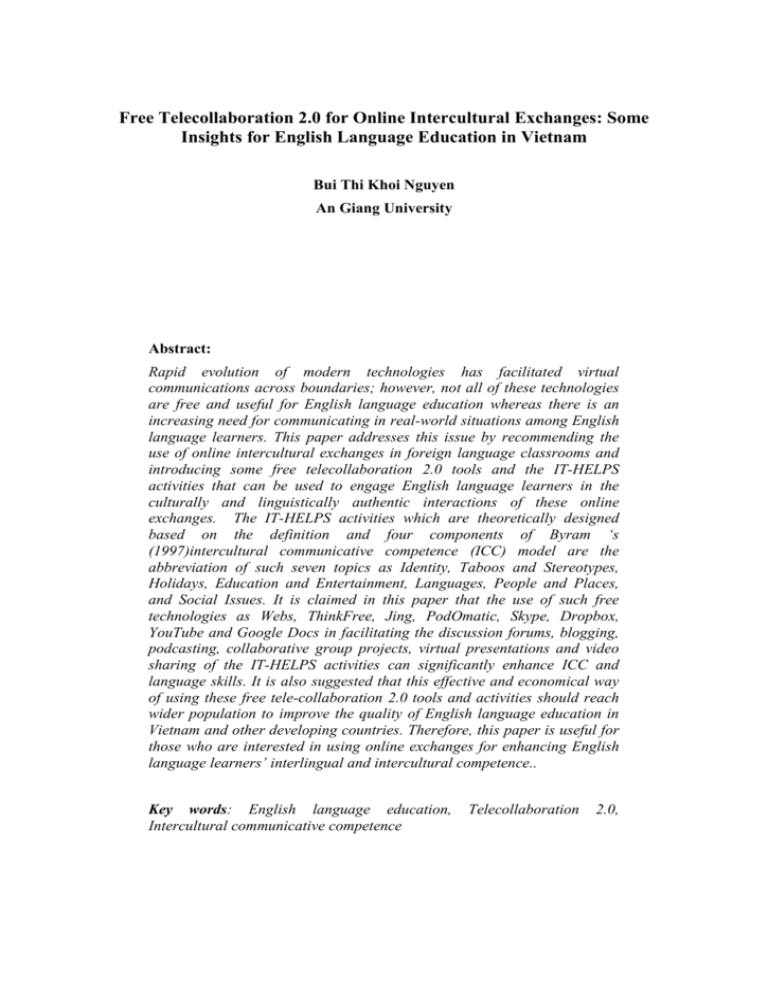
Free Telecollaboration 2.0 for Online Intercultural Exchanges: Some Insights for English Language Education in Vietnam Bui Thi Khoi Nguyen An Giang University Abstract: Rapid evolution of modern technologies has facilitated virtual communications across boundaries; however, not all of these technologies are free and useful for English language education whereas there is an increasing need for communicating in real-world situations among English language learners. This paper addresses this issue by recommending the use of online intercultural exchanges in foreign language classrooms and introducing some free telecollaboration 2.0 tools and the IT-HELPS activities that can be used to engage English language learners in the culturally and linguistically authentic interactions of these online exchanges. The IT-HELPS activities which are theoretically designed based on the definition and four components of Byram ‘s (1997)intercultural communicative competence (ICC) model are the abbreviation of such seven topics as Identity, Taboos and Stereotypes, Holidays, Education and Entertainment, Languages, People and Places, and Social Issues. It is claimed in this paper that the use of such free technologies as Webs, ThinkFree, Jing, PodOmatic, Skype, Dropbox, YouTube and Google Docs in facilitating the discussion forums, blogging, podcasting, collaborative group projects, virtual presentations and video sharing of the IT-HELPS activities can significantly enhance ICC and language skills. It is also suggested that this effective and economical way of using these free tele-collaboration 2.0 tools and activities should reach wider population to improve the quality of English language education in Vietnam and other developing countries. Therefore, this paper is useful for those who are interested in using online exchanges for enhancing English language learners’ interlingual and intercultural competence.. Key words: English language education, Intercultural communicative competence Telecollaboration 2.0, Introduction In today’s global context, with the rapid developments in information and communication technologies (ICT), the thirst for knowledge access and mutual understanding transcends the limitation of geographical boundaries and the different educational and administrative systems between the superpower and less influential countries. In education, the information overload, rapid changes in communication technology, globalization, and new knowledge-acquisition modalities have changed the instruction and use of a target language, enabling new forms of interaction and ways to participate in academic communities (Kern, 2006). Modern technology contributes to transforming or at least to changing the teaching and learning methods, and eventually empowering learners and teachers with more flexibility. However, simply providing access to ICT will not completely make language education better, but exploring their full potential in online exchanges for specific situations and educational goals will. In fact, it is urgent to focus on the meaningful integration of inexpensive ICT into a classroom in order to fill the gaps of learners’ different ethnic background, socioeconomic status, age, educational background and geographical locations. In Vietnam, as other English as a Foreign Language (EFL) countries, it is obvious that the classroom is still preferred as the only environment for English language acquisition and practice while language learners are always trying to be native-like. In order to provide language learners with real communication with people from English speaking countries, many institutions and foreign language centers are willing to pay high salaries to recruit native speakers of English (NSs) for teaching positions, even those without proper ESOL education or teaching training. The need to have authentic communication with NSs is increasing more than ever but the high cost of study abroad tours reach only rich learners or high-paid private English language centers. In this context, providing free technologies and online exchange activities to facilitate authentic conversations in such developing countries as Vietnam is vital. Indeed, with more online opportunities, learners can surely reach out to the world and hence create better chances for authentic communication in the target language and culture. Unfortunately, it is still very true that “even when teachers do believe that technology has empowering potential, they do not always know how to make this happen in the classroom.” (Egbert et al., 2002) In fact, not many language educators can fully explore the available technological tools to connect different language learners across boundaries due to the high cost of educational software and technologies, the moderate technological skills of the users and the lack of task management skills by teachers (Perren, 2001). Some, especially teachers of older generations, are reluctant to apply the new technologies substantially throughout their careers and ignore chances for renewal which waste their time because “they have been successful in the past… they will aim to continue along the (same) path” (Hubbard, 2008, p. 177); Others may be confused about selecting suitable technologies to equip language teaching (Stockwell, 2007) as well as activities and content to be taught in a language classroom of the digital world that can meet the interests of both native speakers of English and the non-native ones. Thus they need cost-free, efficient and easy-to-use technologies in tandem with the suitable activities for practical use. With the aforementioned issues, culture, the fifth language skill (Kramsch, 1993), is thought of to constitute the core of language curriculum while technology is just a tool. Language and culture are inseparable; thus “proficiency-oriented foreign 1 language teaching that fosters effective communication has to take place in a culturally rich environment” (Dubreil, 2006, p. 237). Therefore, this paper discusses the possibility of using free telecollaboration 2.0 tools and relevant IT-HELPS exchange activities to effectively enhance learners’ language skills and intercultural communicative competence. It is suggested here that online exchanges should be an essential part of a language education curriculum thanks to the free access to telecollaboration 2.0 tools which have more dominant features than the previous generation of computer-mediated communication (CMC) technologies and are potentially more effective for language education than ever. Why Should Language Teachers Use Telecollaboration 2.0? Guth and Helm (2010) referred to telecollaboration as “internet-based intercultural exchange between people of different cultural and/ or national backgrounds, set up in an institutional context with the aim of developing both language skills and ICC through structured tasks” (p. 14). Telecollaboration 2.0 refers specifically to telecollaboration with the educational shift from Web 1.0 to Web 2.0 - a network environment in which users can rate, share, respond and comment on other users’ contributions (Steele & Cheater, 2008) and hence it creates “a dialogical conversation” in a globalized and “flat” world (Friedman, 2005) “As well as increasing the different modes in which learners can communicate, exchange, compare and contrast information…” (Guth & Helm, 2010, p.22) In fact, there are numerous benefits in using telecollaboration 2.0 tools for online exchanges. First of all, Web 2.0 focuses more on collaboration, participative elements and the notion of “Web as a platform” (O’Reilly, 2005); therefore, Web 2.0 provides a social networking system in which participants have interactive space to create and distribute the content for communication in the way that Web 1.0 simply failed in comparison (Vossen & Hagemann, 2007). Web 2.0 technologies enable social interactions with learners’ active participation in learner-centered activities to own the content of language production on the Web (Stickler & Emke, 2011) and to respond, share and edit information overtly in public. In addition, Web 2.0 tools allow dynamic and collaborative learning environments (Sclater, 2008) and create “the perceived similarity to a real setting” with the use of video-conferencing for telecollaboration (Yamada & Akahori, 2009, p.19) and recent software. Especially, using Web 2.0 tools in intercultural exchanges makes communication more natural and socially rich for younger learners, i.e, “tech savvy” and “digital natives” (Prensky, 2001). For example, Ivanic et al. (2007) claim that students who have low literacy competence in educational settings can be highly literate in digital practices. Moreover, O’Dowd (2007) found that Web 2.0 tools provide learners with different types of knowledge (i.e., online literacy, language, socio-cultural and professional knowledge) that contribute to the development of cultural awareness when they explicitly compare the two cultures and react directly to the submissions of others in online exchange dialogues. Finally, Web 2.0 tools for telecollaboration can potentially support the development of students’ ICC in a way that traditional culture learning materials would not be able to achieve. Indeed, from an educational standpoint, telecollaboration 2.0 is a tool to “promote reflection, understanding, criticism, equality and transformation” (Guth & Helm, 2010, p. 23). However, Web 2.0 should not be about specific technologies but about people’s desire to connect with each other (Steele & Cheater, 2008). Similarly, Guth and Helm (2010) states that, “in particular Web 2.0 is not merely a tool for mediation but a 2 significant social phenomenon which has generated a multiplicity of new contexts in which people interact” (p. 20). Hence it is essential to pay attention to the design of the telecollaborative activities which can best be facilitated with relevant and effective technologies to achieve the objectives of a language classroom. Specifically, the writer would like to introduce the IT-HELPS activities that she designed with the relevant use of telecollaboration 2.0 tools for the online exchange between an English language class at Tan Tao University in Vietnam and a Second Language Acquisition class at Eastern Michigan University in the United States as follows. What Are the Free Telecollaboration 2.0 Tools Used in the IT-HELPS Activities? The IT-HELPS Activities: The IT-HELPS activities used both asynchronous and synchronous telecollaboration 2.0 tools to facilitate the online discussions, collaborative projects, video/movie/article sharing, video making, new language learning, video conferencing of seven topics abbreviated under the name “IT-HELPS”: Identity, Taboos and Stereotypes, Holidays, Education and Entertainment, Languages, People and Places, and Social Issues. The theoretical foundation in designing these IT-HELPS activities is grounded in the idea that language and culture cannot be separated and hence embedding the nature of culture into language education in the virtual world will foster intercultural communicative competence and language skills significantly. Also, it is believed that learning a foreign language in authentic and virtual communication with native speakers of that target language is more effective, rewarding, meaningful and relaxing. Using the distinct but interdependent principles of Byram’s (1997) model of intercultural communicative competence (ICC), all of the activities were designed based on the objectives indicating the emphasis on skills, knowledge, attitudes and critical cultural awareness while the means of communication is English language. Since most of the language teaching curriculum tends to focus on the dominance of the culture of the target language (C2) only, these IT-HELPS activities intended to localize the learning materials and activities to suit the socio-cultural context of the foreign language learners in EFL countries. Below is the theoretical framework of the ITHELPS activities: Tele-collaboration 2.0 Classroom activities Figure 1: The Design of the IT-HELPS Activities 3 Brief Description of the IT-HELPS Activities: Week 1 - Identity: Participants create self-introduction videos on YouTube and share the links on the IT-HELPS website. Later in the week, students from both universities have a video-conference to discuss what they learn from their online partners’ videos, share their own identity and show some cultural artifacts that personally and culturally represent them. The main purpose is to get to know each other and to create a harmonious and mutual understanding environment of the exchange. Week 2 – Taboos and Stereotypes: In the discussion forum of the IT-HELPS website (on Webs), participants watch a short YouTube videos about the popular custom of eating baluts (fertilized duck eggs) in the Philippines and then discuss issues related to taboos and stereotypes in different cultures. This activity aims to develop participants’ “curiosity, openness and readiness to suspend disbelief about other cultures and belief about one's own” (Byram, 1997, p.50) and thus “identify areas of misunderstanding and dysfunction in an interaction and explain them in terms of each of the cultural systems present” (p.52) Week 3 - Holidays: Participants are grouped to work collaboratively for small group projects. Each group (6-8 students from both Tan Tao University and Eastern Michigan University) is required to discuss the ideas for creating a screen-cast (with Jing) that presents the similarities and differences of a holiday that the group members have in common (between the two cultures or more). Many technological tools can be suggested to share info and discuss ideas among group members of this collaborative project such as email, discussion forum, Meebo bar (on the IT-HELPS website), Skype, Google Docs, ThinkFree and Dropbox. Jing software is recommended for making a screencast - the final product of the project which is similar to a real MS PowerPoint presentation with a slide show, animations and real voices of the presenters recorded in tandem with the mouse movements on the slides. This activity targets the enhancement participants’ ability to “interpret a document or event from another culture, to explain it and relate it to documents from one's own” and “acquire new knowledge of a culture and cultural practices." (Byram, 1997, p.52) Week 4 - Entertainment and Education: On the IT-HELPS website, participants are asked to watch a YouTube video clip about a Vietnamese student in the exchange program in the United States. After that, in the discussion forum, they share insights and opinions about the video, educational and cultural values that reflect a national, the relationship between education, culture and entertainment, and the effect of media on personal beliefs or knowledge/ learned lessons of another culture. The aim of this activity is to increase the participants’ ability to “mediate between conflicting interpretations of phenomena” (Byram, 1997, p. 52) Week 5- Language: Language attempt videos + Discussion (YouTube, Webs) Each group of students (2-3 members in small groups from the same institution) is required to find time/technologies (suggested on the tasks for week 3) to communicate and learn from their group mates (online exchange group members, not from the same institution) to speak at least 4-6 phrases or sentences in another language (not English). After learning this, each group records their actual speaking of these expressions (in that foreign language) and explain (in English) why/ when to use them. Then they are asked to make a two- to five-minute podcast (using PodOmatic) or upload their video on YouTube and share the link on the Discussion forum of the IT-HELPS website. This activity intends to develop opportunities for authentic conversations among speakers of the target languages. 4 Week 6 – People and Places: Each group of participants from the same culture (2-4 members) choose an article (in English) about a famous place for tourism or a hometown that can typically reflect the regional identities of a country or state/province. After sharing the link of the article in the discussion forum of the ITHELPS website, group members are asked to explain their choice and make additional critical comments on the people and language varieties/ dialects/ typical regional rituals or local customs activities of this place. This activity targets the development of the ability “to evaluate critically and on the basis of explicit criteria perspectives, practices and products in one's own and other cultures and countries” (Byram, 1997, p.63). By doing this task, participants are expected to widen their knowledge of a geographical space and its people in another country, make critical evaluation of the document in reference to their explicit perspective and have critical awareness of the landmarks of significant places, the markers of internal and external borders/frontiers within the same country. Week 7- Social Issues: Each group of 2-3 students from the same institution are asked to make a three- to five-minute YouTube video clip of a trend/ local community issue/ social activity/ community service and then discuss the causes/effects/popularity of the issue(s) as well as solutions. To facilitate the online discussion, they share link to their YouTube video in the Discussion Forum of the IT-HELPS website. Some examples are: (1) Trends in the local community: A video about the popularity/ public acceptance of LBGT (Lesbians, Gays, Bisexual,Transexual) through special days, events, posters ...on a campus or in a local community; (2) Social activities/ community service: "Green Summer Volunteer Campaign in Vietnam”/ an orphanage visit/fund raising event for the homeless ...of a local community/ Tree Planting event/ Habitats for Humanity; (3) Local issues (i.e, a polluted area, lack of parking spaces, advertisements) and local solutions; (4) Effects of the globalization on the local community (in various brand names of clothes/ food products/ fast food restaurants, wide spread of internet use in the local community). This activity aims to help participants obtain the abilities to question the values of their own cultural and social environment and critically evaluate a phenomenon of their society. When answering their online friends’ questions, it is hoped that participants will develop the ability to consider conflicting interpretations of phenomena. Free Telecollaboration 2.0 Tools: All of the IT-HELPS activities are designed to foster intercultural communication via an online forum discussion about cultural topics and cultural movies/ TV channels on Webs, real-time chatting on Meebo widget which is on Webs and is linked to Facebook chat, AIM, Google Talk, Windows Live and Meebo chat, blogging on Webs, videos and documents sharing on YouTube and Google Docs, podcasting collaborative projects on PodOmatic, foreign language exchanging on ThinkFree and YouTube, email exchanging, project presentations on Google Docs, video conferencing on Skype, and local community/ holiday webcasting on Jing. These tools are free and have functions that potentially facilitate the targeted activities well. Webs: This free website-development tool is used to create the IT-HELPS website which can be accessed at http://www.it-helps-exchange-program.webs.com. The participants of the online exchange are registered members on this website which is the main site for all asynchronous activities such as sharing links to YouTube videos, 5 posting weekly discussion threads, photos or videos and so on. Especially, functioning as any high paid Learning Management System, this website provides spaces for an organized online forum which is intended to facilitate class discussion very well with compatible and professional features for managing the ongoing posting and responding of the participants. The users also have their own profiles and personal pages to connect friends as a social network and are culturally grouped for the collaborative projects. This website has free but professional features and allows privacy settings for the ten pages of the site including the homepage, discussion forum, videos, blogs, photos, calendar, learning materials and so on as seen in the following screen capture. Figure 2: Example of the IT-HELPS Website Used in the Online Exchange Between Tan Tao University in Vietnam and Eastern Michigan University in the United States Jing: can be used to create the screen-casts that capture everything that happens in the selected area, including the whole oral presentation. Visually recording everything one sees, and does on the screen with just simple mouse movements on the screen, Jing helps users capture and share the screen-cast instantly. After simply pasting the link into any forum post, email or an IM (Instant Message), users can maintain the authentic and lively asynchronous communication across boundaries. PodOmatic: is suggested to be used for recording, creating, distributing and listening to original podcasts and vodcasts because this website provides each user 6 500MB of storage and 15GB of bandwidth per month for free. Uploaded assignments and other files can be stored locally on the user's computer or other devices for offline use. YouTube: This video-sharing website allows users to upload, view and share videos online worldwide. Users can make very professional videos for their assignments and share the links to the online forum of the IT-HELPS website. The other members watch the videos and comment in the discussion forum. ThinkFree: is suggested for collaborative group projects of weeks 3, 6 and 7 of this exchange because ThinkFree Online lets users collaborate on documents with others, and publish to a blog or the web. The WorkSpace on ThinkFree Online has a variety of features to access and manage stored documents and keeps track of the changes that are made to help manage the group members and their assigned tasks easily. Moreover, it keeps documents on the desktop, online and mobile workspaces automatically updated. It also provides a free web office suite with 1 GB of online storage and is compatible with Windows, Mac and Linux. Google Docs: serves as a free collaborative tool for editing documents and creating online presentations of the IT-HELPS members. Documents can be created, shared and edited by multiple users synchronously and asynchronously. Indeed, Google Docs enables the creation of documents, spreadsheets, presentations to be imported through the web interface, or sent via email just with its web links. Users cannot be notified of changes as in ThinkFree but can see the changes made to a document because of the writing in specific colors used by different editors. In addition, it is accessible because of its compatibility with all operating systems. DropBox: is helpful when students have to transfer heavy files for collaborative products because the shared folders allow members to work together on the same projects and documents even offline. This software helps users see other people's changes of the same documents instantly and create photo galleries of folders of shared files viewable by selected viewers. Online technical support: On this IE-HELPS website, there are tutorial videos and a discussion forum to provide technical support for the suggested technologies in the exchange. The participants can also easily ask for help by filling in the Contact box on the IT-HELPS website which automatically sends the questions to the mailbox of the researcher/writer/web admin. Moreover, the online members can chat directly with the web admin by using the Meebo bar at the lower right corner of the IT-HELPS website. Conclusion It is noted that there is a possibility of enhancing intercultural communicative competence and language learning effectively through online exchange programs for free, especially in developing countries like Vietnam. Despite its elusive and complex nature of culture learning, culture plays important roles in language learning; therefore, the aforementioned free telecollaboration 2.0 tools and the IT-HELPS activities are worth being considered to be used for the broader population in future online exchanges that aim to increase participants’ intercultural communicative competence and to provide better language learning. Literature shows that not many previous exchange projects have successfully used completely free telecollaboration 2.0 tools, which are mainly used for daily communication in social life, to facilitate language learning and ICC development in academic settings. It is hoped that these presented ideas will be 7 beneficial for future intercultural projects with the effective application of telecollaboration 2.0 tools and IT-HELPS activities. Regardless of what means of communication to be used, intercultural exchange will remain a vital element in the language learning process (Crozet & Liddicoat, 1999); therefore, it is expected here that these IT-HELPS activities which used free telecollaboration 2.0 tools for working collaboratively online will be widely implemented for language education reform in Vietnam and other developing countries with similar contexts. References Byram, M. (1997). Teaching and assessing intercultural communicative competence. Clevedon, England: Multilingual Matters. Crozet, C., & Liddicoat, A.J. (1999). The challenge of intercultural language teaching: Engaging with culture in the classroom. In J. Lo A.J.Liddicoat, & C. Crozet (Eds), Striving for the third place: Intercultural competence through language education (pp.113-125). Australia: Language Australia. Dubreil, S. (2006). Gaining perspective on culture through CALL. In L. Ducate &N. Arnold (Eds.), Calling on CALL: From theory and research to new directions in foreign language teaching (pp.237-268). Texas: CALICO. Egbert, J., Paulus, T. M., & Nakmichi, Y. (2002).The Impact of CALL instruction on classroom computer use: A foundation for rethinking technology in teacher education. Language Learning & Technology, 6(3), 108–126. Retrieved February 5, 2012, from http://llt.msu.edu/vol6num3/egbert/default.html Guth, S. & Helm, F. (Eds.). (2010). Telecollaboration 2.0: Language literacies and intercultural learning in the 21st Century. Bern: Peter Lang. Hubbard, P. (2008). CALL and the future of language teacher education. CALICO Journal, 25 (2), 175188. Ivanic, R., Edwards, R., Satchwell, C., and Smith, J. (2007). Possibilities for pedagogy in further education: Harnessing the abundance of literacy. British Educational Research Journal, 33(5), 703-721. Kern, R. (2006). Perspectives on technology in learning and teaching languages. TESOL Quarterly, 40 (1), 183-210. Retrieved March 3, 2012 from http://www.jstor.org.ezproxy.mnsu.edu/stable/pdfplus/40264516.pdf?acceptTC=true Kramsch, C. (1993). Context and culture in language teaching. Oxford: Oxford University Press. O’Dowd, R. (2007).Online intercultural exchange: An introduction for foreign language teachers. Clevedon: Multilingual Matters. O’Reilly, T.(2005). What is Web 2.0: Design patterns and business models for the next generation of software. Retrieved March 2, 2012 from http://www.oreillynet.com/pub/a/oreilly/tim/news/2005/09/30/what-is-web-20.html. Perren, J. (2001). Ritual constraints and student perceptions: What can be learned from computermediated writing task? Annual Research Report of the Language Center, 4, 41-62, (A Kwansei Gakuin University in-house journal). Prensky, M. (2001). Digital Natives, Digital Immigrants. On the Horizon, 9(5), 1-6. Retrieved Nov 11, 2011 from http://www.marcprensky.com/writing/Sclater, N. (2008). Web 2.0, personal learning Environments, and the future of learning management Systems. Research Bulletin, Educause, 13, 12. Retrieved Nov 11, 2011 from http://www.educause.edu/ECAR/ResearchPublications/ResearchBulletins/1007 Steele, K & Cheater, M. (2008).Connecting with the Facebook generation: Social media strategies for Web 2.0. Paper presentation to the 2008 AARAO Conference: Diverse Perspectives: A New Generation of Students. Retrieved Nov 23rd, 2011 from http://www.academica.ca/AARAO-2008 or http://www.academica.ca/sites/academicagroup.com/files/SocialMedia.pdf Stickler, U., &Emke, M. (2011) Tandem learning in virtual spaces: Supporting non-formal and informal learning. In H. Reinders &P. Benson (Eds.), Beyond the language classroom: The theory and practice of informal language learning and teaching. Basingstoke: Palgrave Macmillan. Stockwell, G. (2007). A review of technology choice for teaching language skills and areas in the CALL literature. ReCALL, 19, 105-120. doi: 10.1017/S0958344007000225 Vossen, G & Hagemann, S. (2007). Unleashing Web 2.0: From concepts to creativity. Burlington: Morgan Kaufmann. Yamada, M., & Akahori, K. (2009). Awareness and performance through self- and partner's image in videoconferencing. CALICO Journal, 27(1), 1-25. 8
